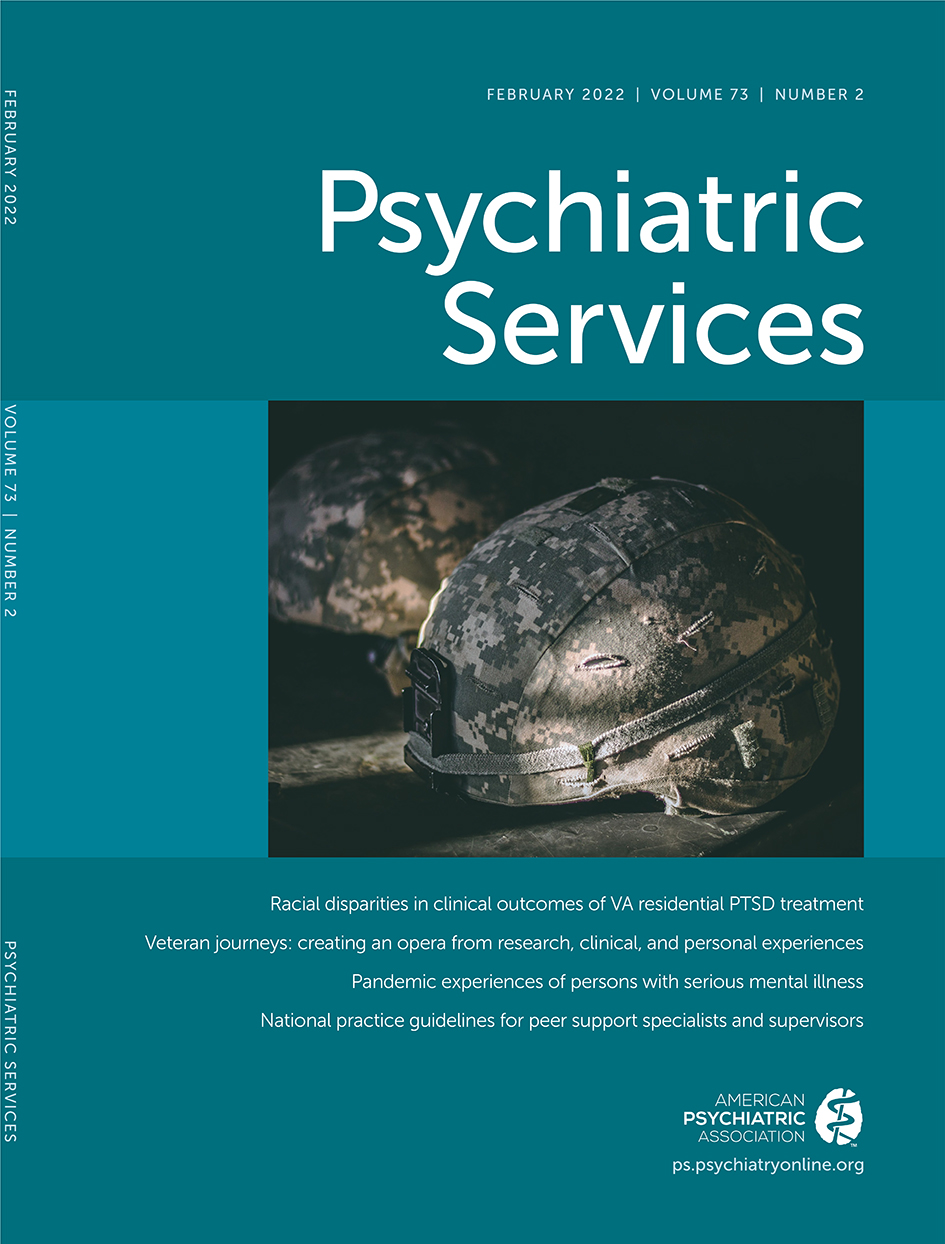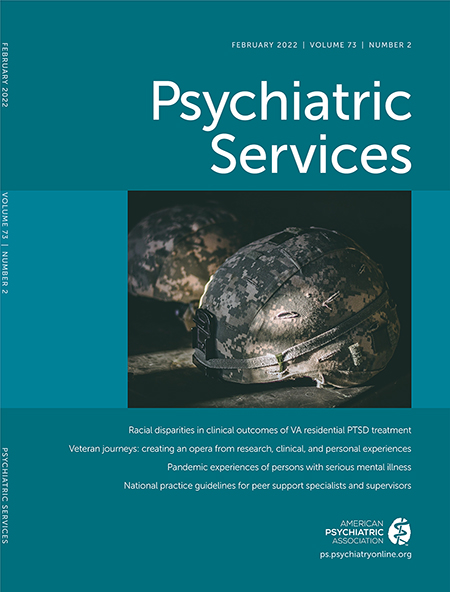Since the outbreak of the COVID-19 pandemic, symptoms of poor mental health have become increasingly prevalent (
1–
3). The prevalence of anxiety and depressive symptoms was particularly high in December 2020, when the United States was experiencing a second wave of the COVID-19 pandemic before the winter holidays, which many Americans spent apart from family, and prior to widespread availability of a vaccine (
4). Factors such as infection and fear of infection, social isolation and loneliness, job loss, and food insecurity may have contributed to stress and poorer mental health (
5,
6). Despite the known impacts of the pandemic on mental health, little is known about the unmet mental health needs of Americans, such as ability to access counseling or therapy, over a period when depressive and anxiety symptoms are widespread, such as during the pandemic (
4). The objective of this study was to estimate the prevalence and sociodemographic correlates of unmet need for mental health counseling among U.S. adults during the COVID-19 pandemic.
Methods
We analyzed data from the December 9–21, 2020, cross-sectional, nationally representative Household Pulse Survey (HPS) (N=69,944), which is conducted by the U.S. Census Bureau in collaboration with five other federal agencies to produce data on the social and economic impacts of COVID-19 among adults in the United States (
https://www.census.gov/householdpulsedata). The Census Bureau Master Address File was used as the source of the sampled household units (
7). This file comprised approximately 140 million housing units, phone contact for over 88% of addresses, and e-mail addresses for almost 80% of home addresses in the United States (
7). The sampling design was a systematic sample of all eligible housing units, with adjustments applied to select a large enough sample to create state- and national-level estimates and estimates for the 15 largest metropolitan statistical areas. Sampled households were contacted by e-mail or text message. The Census Bureau used Qualtrics as the primary data collection method. Research involving unidentifable or deidentifed information that is publicly available is not considered human subjects research by the National Institutes of Health definition because investigators cannot ascertain the identities of the individuals in the data. In these cases, institutional review board approval is not required.
To assess the unmet need for mental health counseling, participants were asked, “At any time in the last 4 weeks, did you need counseling or therapy from a mental health professional but did not get it for any reason?” Response options were yes or no. Depressive symptoms were assessed by using an adapted version of the two-item Patient Health Questionnaire (PHQ-2) (
8). PHQ-2 scores range from 0 to 6, with higher scores indicating more depressive symptoms. Anxiety symptoms were assessed by using an adapted version (i.e., GAD-2) of the seven-item Generalized Anxiety Disorder Scale (
8). GAD-2 scores range from 0 to 6, with higher scores indicating more anxiety symptoms. The time frame was adapted from 2 weeks to 7 days to be consistent with the time frame of other questions in the HPS. A threshold score of ≥3 was used to identify positive screens for both depressive and anxiety symptoms (
8). Age (divided into 10-year increments), sex, race-ethnicity, household income (calculated as below or above the federal poverty line), education (dichotomized to more than high school education versus high school or less), household job loss since March 13, 2020 (yes or no), and current health insurance (yes or no) were based on self-report.
We calculated the unadjusted prevalence of an unmet need for mental health counseling. We used logistic regression to estimate sociodemographic correlates of an unmet need for mental health counseling, including self-reported age, sex, race-ethnicity, income below the federal poverty line, education, insurance, and household job loss during the pandemic among the entire sample and among participants who had screened positive for depression or anxiety. (The amount of missing data for each variable in the analysis and demographic comparisons of participants with complete versus any missing data are shown in the
online supplement.) Multiple imputation by chained equations was used to impute missing data. We applied preconstructed sample weighting to account for nonresponse and coverage of the demographic characteristics of interviewed participants to known age, sex, race, and ethnicity population distributions to yield nationally representative estimates. We used Stata, version 15.1, for all analyses.
Results
Women constituted 51.6% of the sample (N=69,944). Participants were racially and ethnically diverse (62.6% were White, 17.1% Hispanic, 11.1% Black, 5.1% Asian, 4.0% multiple races or other), 18.2% had income below the federal poverty line, 49.5% reported experiencing household job loss during the pandemic, 60.8% had more than a high school education, and 10.7% reported not having current health insurance. Overall, 39.1% of participants had a positive screen for depressive or anxiety symptoms in the past seven days, and 12.8% of participants reported unmet mental health need for counseling in the past month, including 25.2% of those who screened positive for depressive or anxiety symptoms.
Sociodemographic factors (
Table 1) associated with an unmet need for mental health counseling overall included female sex (adjusted odds ratio [AOR]=1.76, 95% confidence interval [CI]=1.56–2.00), income below the federal poverty line (AOR=1.43, 95%=CI 1.21–1.69), higher education (AOR=1.30, 95% CI=1.12–1.51), lack of current health insurance (AOR=1.25, 95% CI=1.02–1.52), and experiencing job loss during the pandemic (AOR=1.99, 95% CI=1.77–2.23). Every decade of older age was associated with lower odds of unmet need for mental health counseling (AOR=0.73, 95% CI=0.70–0.77). Factors that were negatively associated with an unmet need for mental health counseling included Asian race (AOR=0.50, 95%=CI 0.37–0.68), Black race (AOR=0.78, 95% CI=0.65–0.94), and Hispanic/Latino ethnicity (AOR=0.83, 95%=0.69–0.99).
Among participants with a positive screen for depressive or anxiety symptoms, the estimated associations were qualitatively similar. Sociodemographic factors (
Table 1) associated with an unmet need for mental health counseling overall included female sex (AOR=1.51, 95% CI=1.30–1.75), income below the federal poverty line (AOR=1.26, 95% CI=1.04–1.52), higher education (AOR=1.31, 95% CI=1.11–1.55), and experiencing job loss during the pandemic (AOR=1.48, 95% CI=1.29–1.71). Every decade of older age was associated with lower odds of unmet need for mental health counseling (AOR=0.80, 95% CI=0.76–0.85). Factors that were negatively associated with an unmet need for mental health counseling included Asian race (AOR=0.58, 95% CI=0.39–0.85) and Black race (AOR=0.76, 95% CI=0.61–0.94).
Discussion and Conclusions
In this population-based study of U.S. adults from December 2020, participants demonstrated a large unmet need for mental health counseling during the COVID-19 pandemic. Over 12% of adults reported not being able to access mental health counseling services when needed. Notably, this estimate of unmet need for mental health counseling during the pandemic doubled from the estimates in years prior to the pandemic (5.6% in 2017–2018, 6.2% in 2018–2019) (
9,
10). This rate is likely to be an underestimate, given that past studies have demonstrated that many individuals with mental illness do not perceive the need for counseling or therapy (
11) and that the prior comparisons included unmet need for both mental health counseling and treatment.
Women, who have disproportionately borne the burden of child care and caregiving for older adults during the pandemic, and younger adults, who have disproportionately faced job insecurity and social isolation, are at higher risk of an unmet need for mental health counseling and may benefit from additional structural (e.g., employment, financial) or mental health support (
5). Lack of health insurance, living in poverty, and experiencing job loss during the pandemic are risk factors for having an unmet need for mental health counseling.
Despite the social upheaval and mobilization by Black Lives Matter after the murder of George Floyd and despite anti-Asian discrimination and violence (
12), we found that Asian and Black races were negatively associated with unmet need for mental health counseling. Although these findings were initially counterintuitive, it is possible that these populations may be less aware of an unmet mental health need and therefore less likely to self-report an unmet mental health need, even when they are experiencing a diagnosable mental condition. This fits with existing patterns of decreased access to and underutilization of mental health services among members of these two racial groups (
13,
14). Cultural, gender, and educational differences (and the intersection of these factors) may play a role in the perceived need for and acceptance of therapy or counseling specifically (
15). These findings may reflect the need for cultural adaptations of psychological interventions to make them more responsive to the needs of various racial-ethnic groups (
16).
COVID-19 has laid bare the unmet need for mental health counseling that varies across gender and racial lines throughout the adult population. The mental health of the population was closely tied to COVID-19 stressors; the resultant widespread unemployment and social isolation were both fundamental causes of mental health concerns (
5,
6). For example, employment status—whether unemployment, unstable employment, or poor working conditions—is linked to higher rates of psychological distress (
5,
17). Psychological distress due to employment status, financial security, and social support occurs throughout the adult population and disproportionately affects women, those with low income, racial-ethnic minorities, and other marginalized groups (
5,
17). We expanded on the previous literature on social determinants of mental health by showing that experiencing household job loss during the pandemic was associated with an unmet need for mental health counseling.
There is a critical need to understand how the social determinants of mental health present at the population level, particularly as a result of COVID-19, and to identify multilevel structural interventions that will address the unmet need for mental health counseling at the individual, family, and population levels (
17). Future research should explore how schooling pressures relate to mental health and unmet mental health needs during the pandemic, particularly for women. Understanding and identifying these determinants of mental health provides an opportunity to inform structural interventions to reduce poor mental health outcomes.
Limitations of the study included missing data (21.7% of income data); however, we used multiple imputation by chained equations to address this limitation. Participants with missing data were more likely to be members of racial-ethnic minority groups, be younger, and have lower educational attainment. The use of self-reported measures may be subject to reporting bias. The cross-sectional design precluded causal interpretations. The question about unmet mental health need in the HPS was specific to counseling or therapy and did not inquire about an unmet mental health need for medication, which is an important area of future research.
Although mental health services are now offered via telehealth (
2), this service may have limitations in addressing the mental health burden of Americans, particularly related to equity in access and utilization (
3). To address these limitations, population mental health interventions at the individual, community, and national levels should be expanded during the pandemic (
18). Furthermore, policy makers should extend the use of telehealth past emergency use during the pandemic to ensure that it continues to be used to increase access to services even after the pandemic is over. Pandemic relief legislation should also include funding for mental health services to address widespread unmet mental health need for counseling.

